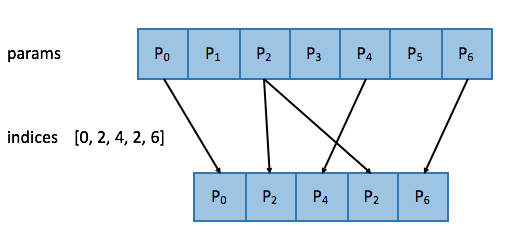mindspore.Tensor.gather
- mindspore.Tensor.gather(dim, index) Tensor[源代码]
返回输入Tensor在指定 index 对应的元素组成的切片。公式如下:
警告
在Ascend后端,以下场景将导致不可预测的行为:
正向执行流程中,当 index 的取值不在范围
反向执行流程中,当 index 的取值不在范围
- 参数:
dim (int) - 指定要切片的维度索引。取值范围
index (Tensor) - 指定原始Tensor中要切片的索引。数据类型必须是int32或int64。需要同时满足以下条件:
对于
index 的取值在有效区间
- 返回:
Tensor,数据类型与 self 保持一致,shape与 index 保持一致。
- 异常:
ValueError - index 的shape取值非法。
ValueError - dim 取值不在有效范围
ValueError - index 的值不在有效范围。
TypeError - index 的数据类型非法。
- 支持平台:
AscendGPUCPU
样例:
>>> import mindspore >>> import numpy as np >>> from mindspore import Tensor >>> input = Tensor(np.array([[-0.1, 0.3, 3.6], [0.4, 0.5, -3.2]]), mindspore.float32) >>> index = Tensor(np.array([[0, 0], [1, 1]]), mindspore.int32) >>> output = input.gather(1, index) >>> print(output) [[-0.1 -0.1] [0.5 0.5]]
返回输入Tensor在指定 axis 上 input_indices 索引对应的元素组成的切片。
下图展示了Gather常用的计算过程:

其中,params代表输入 input_params ,indices代表要切片的索引 input_indices 。
说明
input_indices的值必须在
Ascend平台上,input_params的数据类型当前不能是 bool 。
- 参数:
input_indices (Tensor) - 要切片的索引Tensor,shape为
axis (Union(int, Tensor[int])) - 指定要切片的维度索引。它必须要大于或等于 batch_dims。若 axis 为Tensor,其size必须为1。
batch_dims (int,可选) - 指定batch维的数量。它必须要小于或等于 input_indices 的rank。默认值:
0。
- 返回:
Tensor,shape为
- 异常:
TypeError - axis 不是int或Tensor。
ValueError - axis 为Tensor时,size不为1。
TypeError - input_params 不是Tensor。
TypeError - input_indices 不是int类型的Tensor。
RuntimeError - input_indices 在CPU或GPU平台超出
- 支持平台:
AscendGPUCPU
样例:
>>> import mindspore >>> import numpy as np >>> from mindspore import Tensor >>> # case1: input_indices is a Tensor with shape (5, ). >>> input_params = Tensor(np.array([1, 2, 3, 4, 5, 6, 7]), mindspore.float32) >>> input_indices = Tensor(np.array([0, 2, 4, 2, 6]), mindspore.int32) >>> axis = 0 >>> output = input_params.gather(input_indices=input_indices, axis=axis) >>> print(output) [1. 3. 5. 3. 7.] >>> # case2: input_indices is a Tensor with shape (2, 2). When the input_params has one dimension, >>> # the output shape is equal to the input_indices shape. >>> input_indices = Tensor(np.array([[0, 2], [2, 6]]), mindspore.int32) >>> axis = 0 >>> output = input_params.gather(input_indices=input_indices, axis=axis) >>> print(output) [[1. 3.] [3. 7.]] >>> # case3: input_indices is a Tensor with shape (2, ) and >>> # input_params is a Tensor with shape (3, 4) and axis is 0. >>> input_params = Tensor(np.array([[1, 2, 3, 4], [5, 6, 7, 8], [9, 10, 11, 12]]), mindspore.float32) >>> input_indices = Tensor(np.array([0, 2]), mindspore.int32) >>> axis = 0 >>> output = input_params.gather(input_indices=input_indices, axis=axis) >>> print(output) [[ 1. 2. 3. 4.] [ 9. 10. 11. 12.]] >>> # case4: input_indices is a Tensor with shape (2, ) and >>> # input_params is a Tensor with shape (3, 4) and axis is 1, batch_dims is 1. >>> input_params = Tensor(np.array([[1, 2, 3, 4], [5, 6, 7, 8], [9, 10, 11, 12]]), mindspore.float32) >>> input_indices = Tensor(np.array([0, 2, 1]), mindspore.int32) >>> axis = 1 >>> batch_dims = 1 >>> output = input_params.gather(input_indices, axis, batch_dims) >>> print(output) [ 1. 7. 10.]